Accounting Principles and Financial Statements for Sole Traders, Partnerships, and Non-Profit Organizations
VerifiedAdded on 2023/06/04
|23
|5270
|391
AI Summary
This report explains accounting principles and their purpose in organizations. It examines the accounting function within an organization in the context of regulatory and ethical constraints. It also provides financial statements for sole traders, partnerships, and non-profit organizations. The report evaluates the role of accounting in decision making to meet organizational, stakeholder, and societal needs within complex operating environments.
Contribute Materials
Your contribution can guide someone’s learning journey. Share your
documents today.

Accounting
Principle
Principle
Secure Best Marks with AI Grader
Need help grading? Try our AI Grader for instant feedback on your assignments.
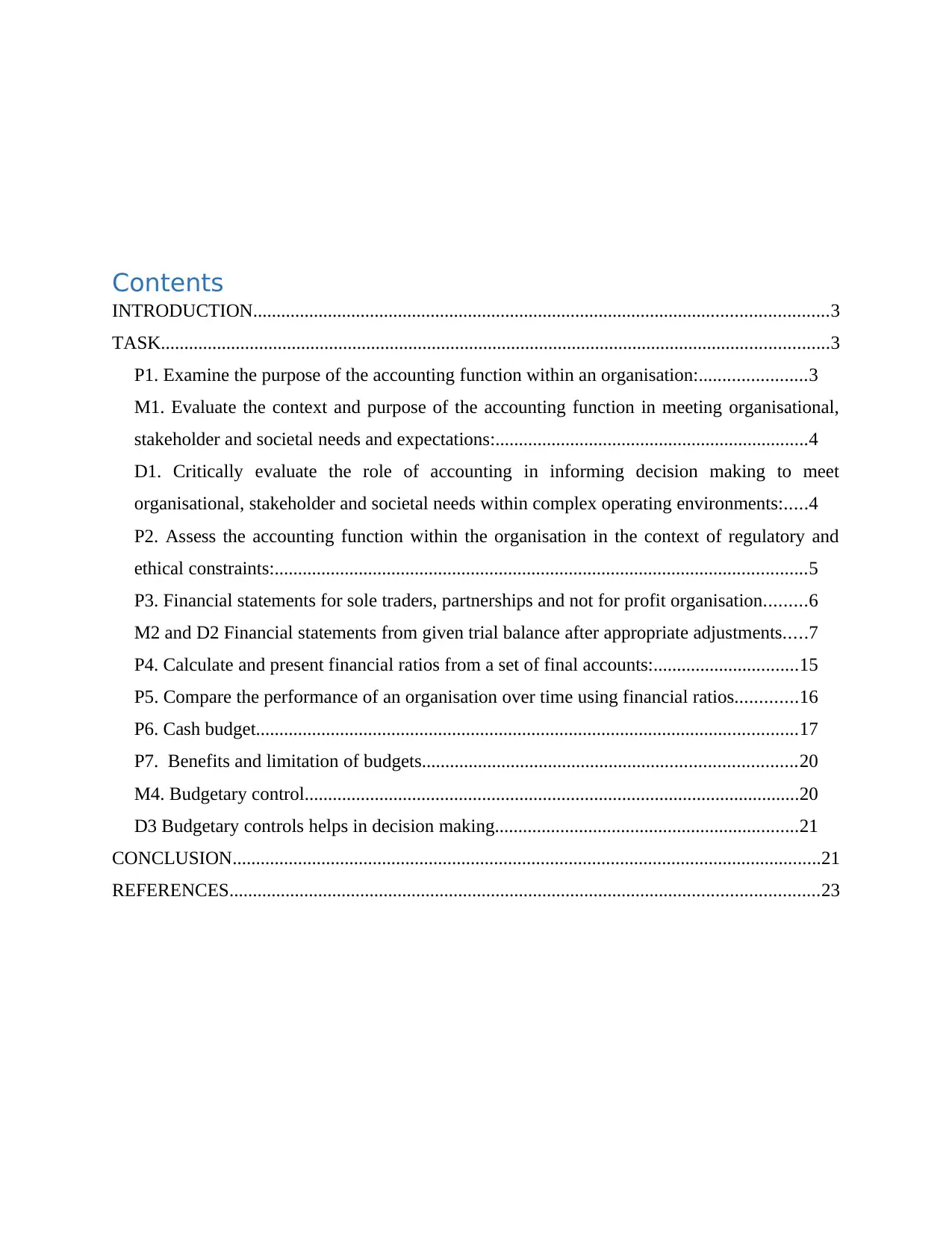
Contents
INTRODUCTION...........................................................................................................................3
TASK...............................................................................................................................................3
P1. Examine the purpose of the accounting function within an organisation:.......................3
M1. Evaluate the context and purpose of the accounting function in meeting organisational,
stakeholder and societal needs and expectations:...................................................................4
D1. Critically evaluate the role of accounting in informing decision making to meet
organisational, stakeholder and societal needs within complex operating environments:.....4
P2. Assess the accounting function within the organisation in the context of regulatory and
ethical constraints:..................................................................................................................5
P3. Financial statements for sole traders, partnerships and not for profit organisation.........6
M2 and D2 Financial statements from given trial balance after appropriate adjustments.....7
P4. Calculate and present financial ratios from a set of final accounts:...............................15
P5. Compare the performance of an organisation over time using financial ratios.............16
P6. Cash budget....................................................................................................................17
P7. Benefits and limitation of budgets................................................................................20
M4. Budgetary control..........................................................................................................20
D3 Budgetary controls helps in decision making.................................................................21
CONCLUSION..............................................................................................................................21
REFERENCES..............................................................................................................................23
INTRODUCTION...........................................................................................................................3
TASK...............................................................................................................................................3
P1. Examine the purpose of the accounting function within an organisation:.......................3
M1. Evaluate the context and purpose of the accounting function in meeting organisational,
stakeholder and societal needs and expectations:...................................................................4
D1. Critically evaluate the role of accounting in informing decision making to meet
organisational, stakeholder and societal needs within complex operating environments:.....4
P2. Assess the accounting function within the organisation in the context of regulatory and
ethical constraints:..................................................................................................................5
P3. Financial statements for sole traders, partnerships and not for profit organisation.........6
M2 and D2 Financial statements from given trial balance after appropriate adjustments.....7
P4. Calculate and present financial ratios from a set of final accounts:...............................15
P5. Compare the performance of an organisation over time using financial ratios.............16
P6. Cash budget....................................................................................................................17
P7. Benefits and limitation of budgets................................................................................20
M4. Budgetary control..........................................................................................................20
D3 Budgetary controls helps in decision making.................................................................21
CONCLUSION..............................................................................................................................21
REFERENCES..............................................................................................................................23

INTRODUCTION
Accounting principles refers to the rules, guidelines, regulations which must have to be
followed by the business organisation and other institutions when they are reporting financial
data (Lucas, 2021). These rules and regulates make the work of the organisation easier and
effective in analysing the financial condition of the business. The one and only specific goal of
accounting principle is to ensure that the financial statement of the organisation are
accomplished, compatible and proportional. This report includes complete explanation about the
accounting principles, and purpose of accounting. Further this report also includes financial
statement and ratio analysis. Remaining parts of the project are going to be discussed in the
below report.
TASK
P1. Examine the purpose of the accounting function within an organisation:
Definition of Accounting- Accounting is the process of identifying, recording, analyzing and
reporting financial information to owners and other users. This is a broader term. The accounting
function plays a vital role in an organization. Accounting features help organizations keep track
of their financial data, which will help them keep financial records. These functions will assist
senior management in decision making.
The purposes of accounting are as follows-
For identification and recording of transaction- The very first purpose of accounting is
the identification and recording of the transaction of business. Due to this the separate
books of accounts can be prepared easily. Due to this the organisations did not have to
do any extra effort for finding any transaction which have passed through out the year.
For determining the result- The another purpose of accounting is to determine the result of the
business organisation. If the organisation have earn enough profit then can continue with the
same strategy. But if the organisation suffer from the loss then they have to make more effective
and efficient strategy so that they can achieve their target in the next year (Czerny and Juras,
2018).
To determine the financial assets and liabilities- Accounting includes all the financial
statement which includes assets and liabilities through the owners of the organisation can
determine the actual value of their assets and liabilities.
Accounting principles refers to the rules, guidelines, regulations which must have to be
followed by the business organisation and other institutions when they are reporting financial
data (Lucas, 2021). These rules and regulates make the work of the organisation easier and
effective in analysing the financial condition of the business. The one and only specific goal of
accounting principle is to ensure that the financial statement of the organisation are
accomplished, compatible and proportional. This report includes complete explanation about the
accounting principles, and purpose of accounting. Further this report also includes financial
statement and ratio analysis. Remaining parts of the project are going to be discussed in the
below report.
TASK
P1. Examine the purpose of the accounting function within an organisation:
Definition of Accounting- Accounting is the process of identifying, recording, analyzing and
reporting financial information to owners and other users. This is a broader term. The accounting
function plays a vital role in an organization. Accounting features help organizations keep track
of their financial data, which will help them keep financial records. These functions will assist
senior management in decision making.
The purposes of accounting are as follows-
For identification and recording of transaction- The very first purpose of accounting is
the identification and recording of the transaction of business. Due to this the separate
books of accounts can be prepared easily. Due to this the organisations did not have to
do any extra effort for finding any transaction which have passed through out the year.
For determining the result- The another purpose of accounting is to determine the result of the
business organisation. If the organisation have earn enough profit then can continue with the
same strategy. But if the organisation suffer from the loss then they have to make more effective
and efficient strategy so that they can achieve their target in the next year (Czerny and Juras,
2018).
To determine the financial assets and liabilities- Accounting includes all the financial
statement which includes assets and liabilities through the owners of the organisation can
determine the actual value of their assets and liabilities.
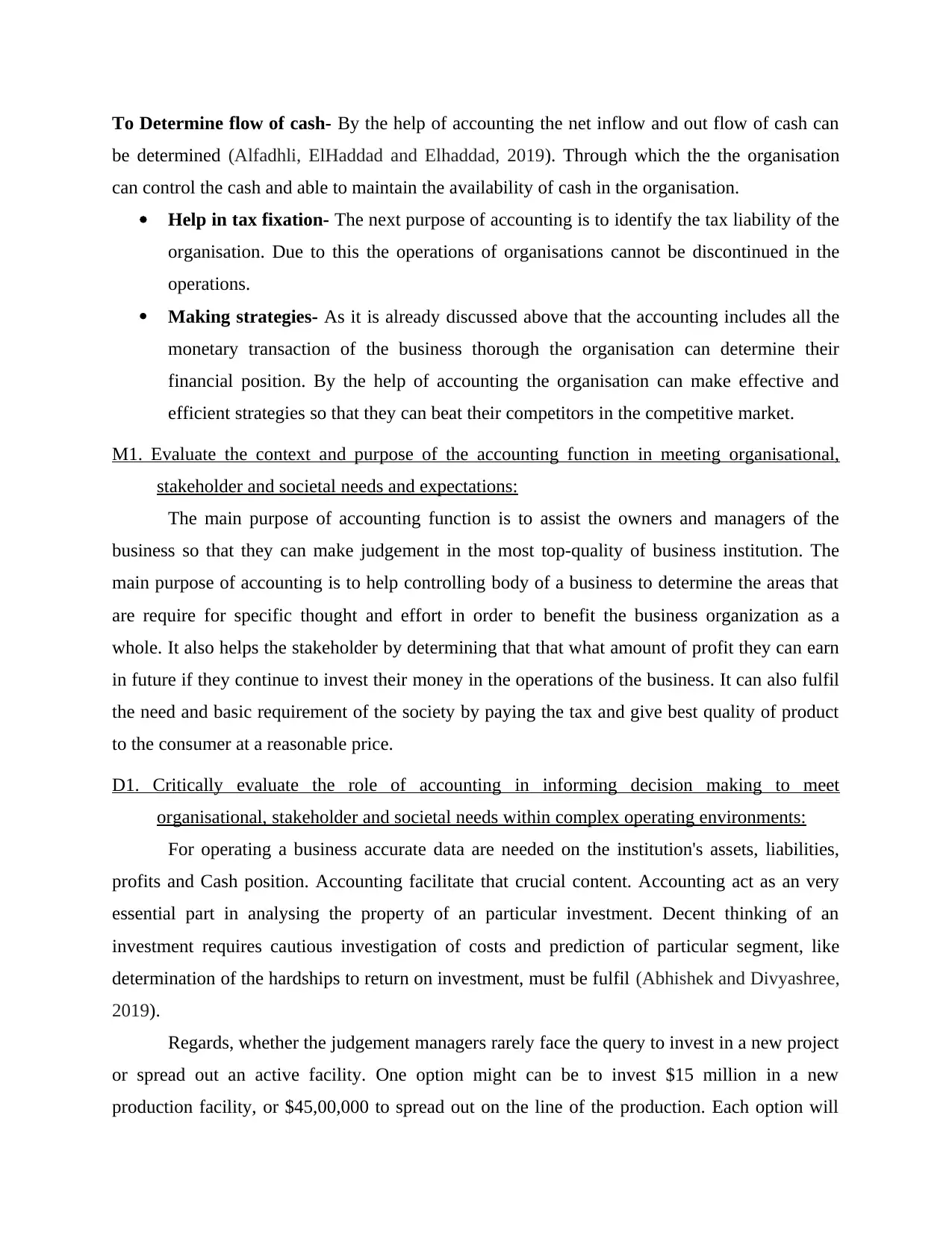
To Determine flow of cash- By the help of accounting the net inflow and out flow of cash can
be determined (Alfadhli, ElHaddad and Elhaddad, 2019). Through which the the organisation
can control the cash and able to maintain the availability of cash in the organisation.
Help in tax fixation- The next purpose of accounting is to identify the tax liability of the
organisation. Due to this the operations of organisations cannot be discontinued in the
operations.
Making strategies- As it is already discussed above that the accounting includes all the
monetary transaction of the business thorough the organisation can determine their
financial position. By the help of accounting the organisation can make effective and
efficient strategies so that they can beat their competitors in the competitive market.
M1. Evaluate the context and purpose of the accounting function in meeting organisational,
stakeholder and societal needs and expectations:
The main purpose of accounting function is to assist the owners and managers of the
business so that they can make judgement in the most top-quality of business institution. The
main purpose of accounting is to help controlling body of a business to determine the areas that
are require for specific thought and effort in order to benefit the business organization as a
whole. It also helps the stakeholder by determining that that what amount of profit they can earn
in future if they continue to invest their money in the operations of the business. It can also fulfil
the need and basic requirement of the society by paying the tax and give best quality of product
to the consumer at a reasonable price.
D1. Critically evaluate the role of accounting in informing decision making to meet
organisational, stakeholder and societal needs within complex operating environments:
For operating a business accurate data are needed on the institution's assets, liabilities,
profits and Cash position. Accounting facilitate that crucial content. Accounting act as an very
essential part in analysing the property of an particular investment. Decent thinking of an
investment requires cautious investigation of costs and prediction of particular segment, like
determination of the hardships to return on investment, must be fulfil (Abhishek and Divyashree,
2019).
Regards, whether the judgement managers rarely face the query to invest in a new project
or spread out an active facility. One option might can be to invest $15 million in a new
production facility, or $45,00,000 to spread out on the line of the production. Each option will
be determined (Alfadhli, ElHaddad and Elhaddad, 2019). Through which the the organisation
can control the cash and able to maintain the availability of cash in the organisation.
Help in tax fixation- The next purpose of accounting is to identify the tax liability of the
organisation. Due to this the operations of organisations cannot be discontinued in the
operations.
Making strategies- As it is already discussed above that the accounting includes all the
monetary transaction of the business thorough the organisation can determine their
financial position. By the help of accounting the organisation can make effective and
efficient strategies so that they can beat their competitors in the competitive market.
M1. Evaluate the context and purpose of the accounting function in meeting organisational,
stakeholder and societal needs and expectations:
The main purpose of accounting function is to assist the owners and managers of the
business so that they can make judgement in the most top-quality of business institution. The
main purpose of accounting is to help controlling body of a business to determine the areas that
are require for specific thought and effort in order to benefit the business organization as a
whole. It also helps the stakeholder by determining that that what amount of profit they can earn
in future if they continue to invest their money in the operations of the business. It can also fulfil
the need and basic requirement of the society by paying the tax and give best quality of product
to the consumer at a reasonable price.
D1. Critically evaluate the role of accounting in informing decision making to meet
organisational, stakeholder and societal needs within complex operating environments:
For operating a business accurate data are needed on the institution's assets, liabilities,
profits and Cash position. Accounting facilitate that crucial content. Accounting act as an very
essential part in analysing the property of an particular investment. Decent thinking of an
investment requires cautious investigation of costs and prediction of particular segment, like
determination of the hardships to return on investment, must be fulfil (Abhishek and Divyashree,
2019).
Regards, whether the judgement managers rarely face the query to invest in a new project
or spread out an active facility. One option might can be to invest $15 million in a new
production facility, or $45,00,000 to spread out on the line of the production. Each option will
Secure Best Marks with AI Grader
Need help grading? Try our AI Grader for instant feedback on your assignments.
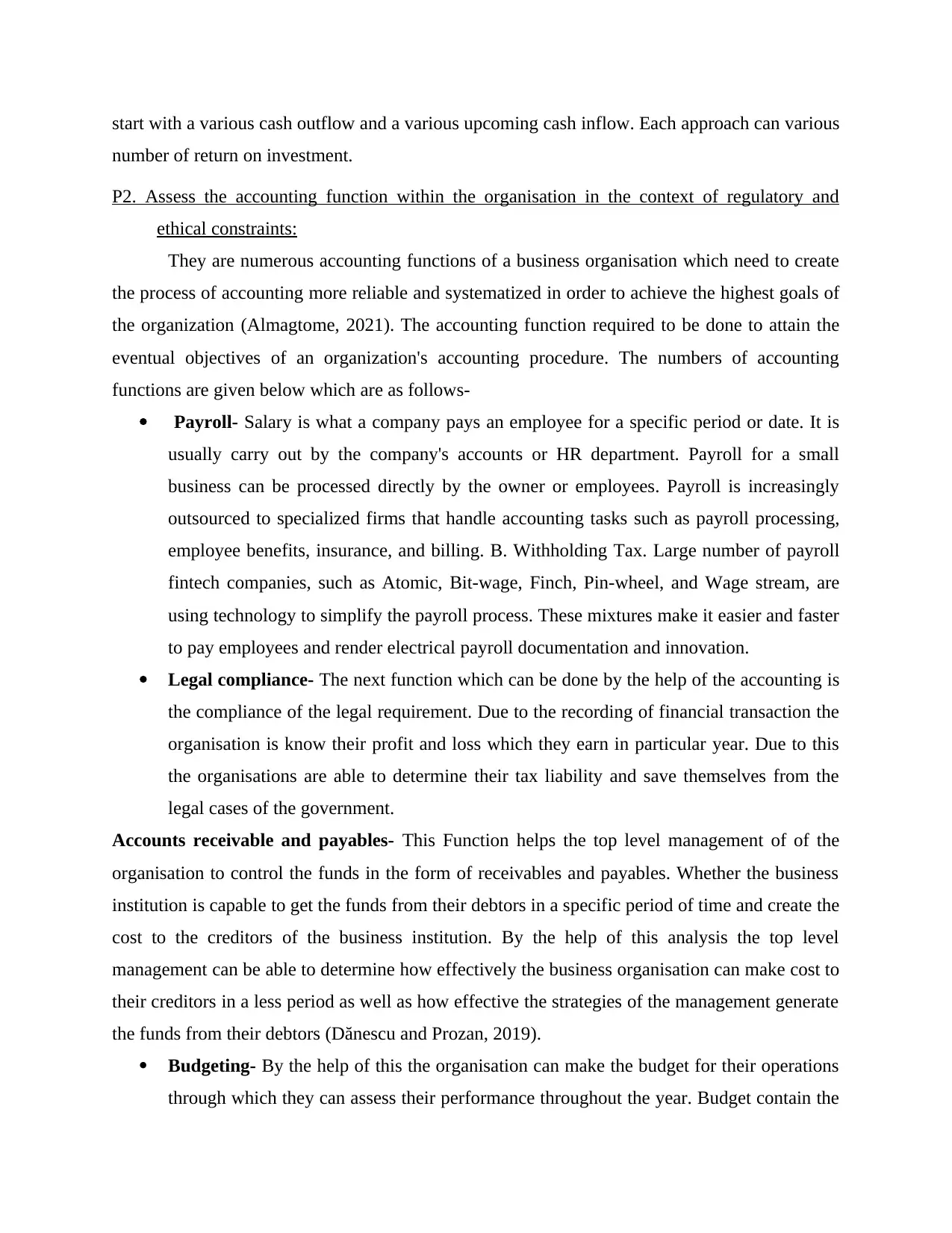
start with a various cash outflow and a various upcoming cash inflow. Each approach can various
number of return on investment.
P2. Assess the accounting function within the organisation in the context of regulatory and
ethical constraints:
They are numerous accounting functions of a business organisation which need to create
the process of accounting more reliable and systematized in order to achieve the highest goals of
the organization (Almagtome, 2021). The accounting function required to be done to attain the
eventual objectives of an organization's accounting procedure. The numbers of accounting
functions are given below which are as follows-
Payroll- Salary is what a company pays an employee for a specific period or date. It is
usually carry out by the company's accounts or HR department. Payroll for a small
business can be processed directly by the owner or employees. Payroll is increasingly
outsourced to specialized firms that handle accounting tasks such as payroll processing,
employee benefits, insurance, and billing. B. Withholding Tax. Large number of payroll
fintech companies, such as Atomic, Bit-wage, Finch, Pin-wheel, and Wage stream, are
using technology to simplify the payroll process. These mixtures make it easier and faster
to pay employees and render electrical payroll documentation and innovation.
Legal compliance- The next function which can be done by the help of the accounting is
the compliance of the legal requirement. Due to the recording of financial transaction the
organisation is know their profit and loss which they earn in particular year. Due to this
the organisations are able to determine their tax liability and save themselves from the
legal cases of the government.
Accounts receivable and payables- This Function helps the top level management of of the
organisation to control the funds in the form of receivables and payables. Whether the business
institution is capable to get the funds from their debtors in a specific period of time and create the
cost to the creditors of the business institution. By the help of this analysis the top level
management can be able to determine how effectively the business organisation can make cost to
their creditors in a less period as well as how effective the strategies of the management generate
the funds from their debtors (Dănescu and Prozan, 2019).
Budgeting- By the help of this the organisation can make the budget for their operations
through which they can assess their performance throughout the year. Budget contain the
number of return on investment.
P2. Assess the accounting function within the organisation in the context of regulatory and
ethical constraints:
They are numerous accounting functions of a business organisation which need to create
the process of accounting more reliable and systematized in order to achieve the highest goals of
the organization (Almagtome, 2021). The accounting function required to be done to attain the
eventual objectives of an organization's accounting procedure. The numbers of accounting
functions are given below which are as follows-
Payroll- Salary is what a company pays an employee for a specific period or date. It is
usually carry out by the company's accounts or HR department. Payroll for a small
business can be processed directly by the owner or employees. Payroll is increasingly
outsourced to specialized firms that handle accounting tasks such as payroll processing,
employee benefits, insurance, and billing. B. Withholding Tax. Large number of payroll
fintech companies, such as Atomic, Bit-wage, Finch, Pin-wheel, and Wage stream, are
using technology to simplify the payroll process. These mixtures make it easier and faster
to pay employees and render electrical payroll documentation and innovation.
Legal compliance- The next function which can be done by the help of the accounting is
the compliance of the legal requirement. Due to the recording of financial transaction the
organisation is know their profit and loss which they earn in particular year. Due to this
the organisations are able to determine their tax liability and save themselves from the
legal cases of the government.
Accounts receivable and payables- This Function helps the top level management of of the
organisation to control the funds in the form of receivables and payables. Whether the business
institution is capable to get the funds from their debtors in a specific period of time and create the
cost to the creditors of the business institution. By the help of this analysis the top level
management can be able to determine how effectively the business organisation can make cost to
their creditors in a less period as well as how effective the strategies of the management generate
the funds from their debtors (Dănescu and Prozan, 2019).
Budgeting- By the help of this the organisation can make the budget for their operations
through which they can assess their performance throughout the year. Budget contain the
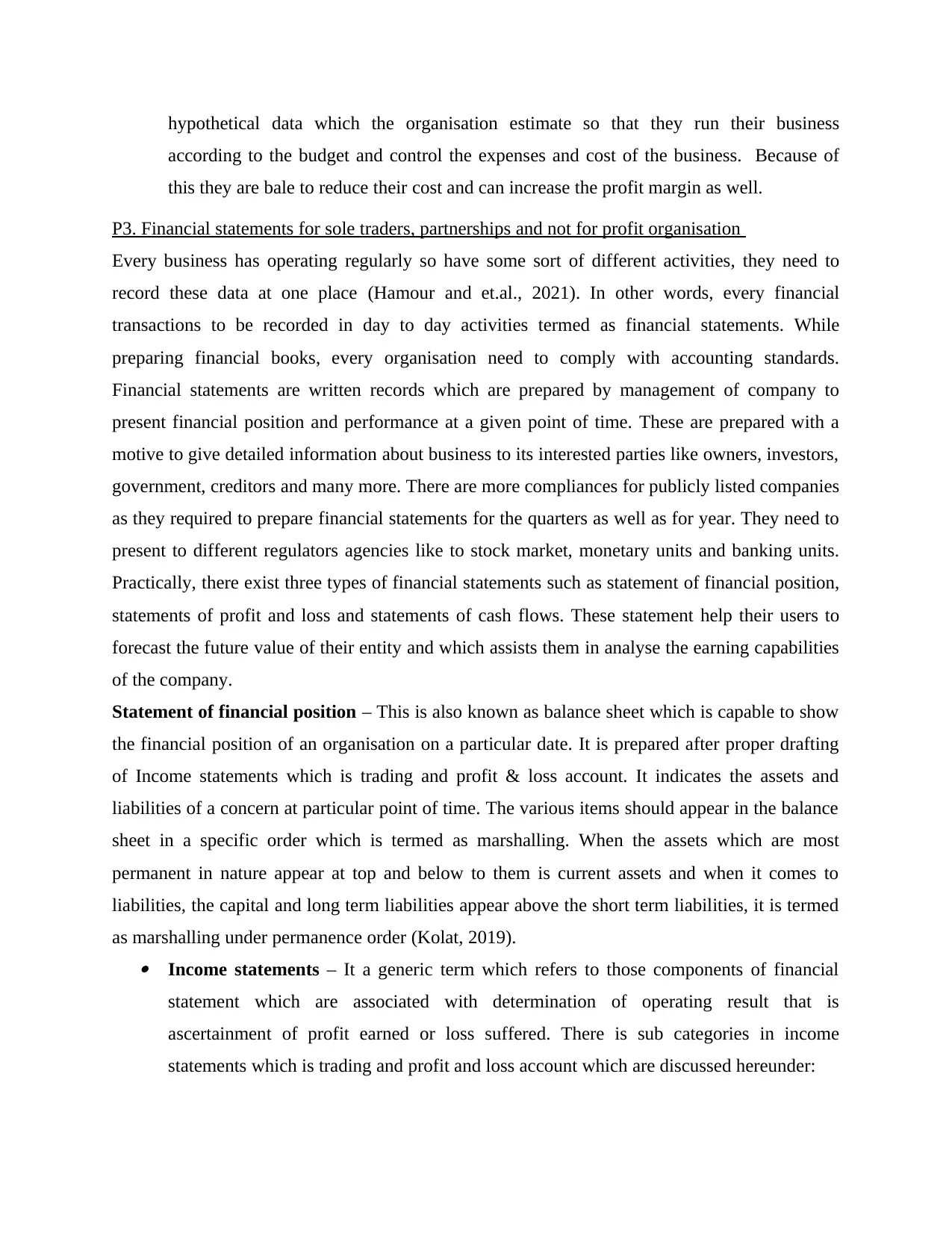
hypothetical data which the organisation estimate so that they run their business
according to the budget and control the expenses and cost of the business. Because of
this they are bale to reduce their cost and can increase the profit margin as well.
P3. Financial statements for sole traders, partnerships and not for profit organisation
Every business has operating regularly so have some sort of different activities, they need to
record these data at one place (Hamour and et.al., 2021). In other words, every financial
transactions to be recorded in day to day activities termed as financial statements. While
preparing financial books, every organisation need to comply with accounting standards.
Financial statements are written records which are prepared by management of company to
present financial position and performance at a given point of time. These are prepared with a
motive to give detailed information about business to its interested parties like owners, investors,
government, creditors and many more. There are more compliances for publicly listed companies
as they required to prepare financial statements for the quarters as well as for year. They need to
present to different regulators agencies like to stock market, monetary units and banking units.
Practically, there exist three types of financial statements such as statement of financial position,
statements of profit and loss and statements of cash flows. These statement help their users to
forecast the future value of their entity and which assists them in analyse the earning capabilities
of the company.
Statement of financial position – This is also known as balance sheet which is capable to show
the financial position of an organisation on a particular date. It is prepared after proper drafting
of Income statements which is trading and profit & loss account. It indicates the assets and
liabilities of a concern at particular point of time. The various items should appear in the balance
sheet in a specific order which is termed as marshalling. When the assets which are most
permanent in nature appear at top and below to them is current assets and when it comes to
liabilities, the capital and long term liabilities appear above the short term liabilities, it is termed
as marshalling under permanence order (Kolat, 2019). Income statements – It a generic term which refers to those components of financial
statement which are associated with determination of operating result that is
ascertainment of profit earned or loss suffered. There is sub categories in income
statements which is trading and profit and loss account which are discussed hereunder:
according to the budget and control the expenses and cost of the business. Because of
this they are bale to reduce their cost and can increase the profit margin as well.
P3. Financial statements for sole traders, partnerships and not for profit organisation
Every business has operating regularly so have some sort of different activities, they need to
record these data at one place (Hamour and et.al., 2021). In other words, every financial
transactions to be recorded in day to day activities termed as financial statements. While
preparing financial books, every organisation need to comply with accounting standards.
Financial statements are written records which are prepared by management of company to
present financial position and performance at a given point of time. These are prepared with a
motive to give detailed information about business to its interested parties like owners, investors,
government, creditors and many more. There are more compliances for publicly listed companies
as they required to prepare financial statements for the quarters as well as for year. They need to
present to different regulators agencies like to stock market, monetary units and banking units.
Practically, there exist three types of financial statements such as statement of financial position,
statements of profit and loss and statements of cash flows. These statement help their users to
forecast the future value of their entity and which assists them in analyse the earning capabilities
of the company.
Statement of financial position – This is also known as balance sheet which is capable to show
the financial position of an organisation on a particular date. It is prepared after proper drafting
of Income statements which is trading and profit & loss account. It indicates the assets and
liabilities of a concern at particular point of time. The various items should appear in the balance
sheet in a specific order which is termed as marshalling. When the assets which are most
permanent in nature appear at top and below to them is current assets and when it comes to
liabilities, the capital and long term liabilities appear above the short term liabilities, it is termed
as marshalling under permanence order (Kolat, 2019). Income statements – It a generic term which refers to those components of financial
statement which are associated with determination of operating result that is
ascertainment of profit earned or loss suffered. There is sub categories in income
statements which is trading and profit and loss account which are discussed hereunder:

Trading account – This is first income statement prepared by non-corporate business entity. It is
used to ascertain gross operating results which can be gross loss or gross profit. Its principle
involves matching of Cost of Goods Sold (COGS) of a financial period against the corresponding
sales (Lopez, Schuldt and Vega, 2022). It considers only direct costs and direct income for
determination of gross profit or gross loss. By nature, it can be considered as nominal account as
it is closed by transferring balance amount to profit and loss.
Profit and Loss account – The second income statement which is drafted after
determination of gross operating results. The main motive of this account to
determine net profit or net loss of an organisation for a particular financial year.
While preparing this account, it considers indirect expenses and losses against the
gross profit and other indirect incomes.
Cash flow statements – This statements help you provide critical overview of inflows and
outflows of cash and cash equivalent in an organisation. The cash go with the drift declaration
has the statistics displaying the inflows of cash in addition to the sources. Besides, it additionally
well-known shows how the commercial enterprise makes use of the outflows to finance the
numerous activities. It is a critical declaration that aids each investor to recognize the monetary
decision-making of the organisation they are inclined to make investments in (Mamazhonov,
2020).
M2 and D2 Financial statements from given trial balance after appropriate adjustments
Financial statements of M queen ( sole trader )
Income statements for the year ended 31st December 2021
used to ascertain gross operating results which can be gross loss or gross profit. Its principle
involves matching of Cost of Goods Sold (COGS) of a financial period against the corresponding
sales (Lopez, Schuldt and Vega, 2022). It considers only direct costs and direct income for
determination of gross profit or gross loss. By nature, it can be considered as nominal account as
it is closed by transferring balance amount to profit and loss.
Profit and Loss account – The second income statement which is drafted after
determination of gross operating results. The main motive of this account to
determine net profit or net loss of an organisation for a particular financial year.
While preparing this account, it considers indirect expenses and losses against the
gross profit and other indirect incomes.
Cash flow statements – This statements help you provide critical overview of inflows and
outflows of cash and cash equivalent in an organisation. The cash go with the drift declaration
has the statistics displaying the inflows of cash in addition to the sources. Besides, it additionally
well-known shows how the commercial enterprise makes use of the outflows to finance the
numerous activities. It is a critical declaration that aids each investor to recognize the monetary
decision-making of the organisation they are inclined to make investments in (Mamazhonov,
2020).
M2 and D2 Financial statements from given trial balance after appropriate adjustments
Financial statements of M queen ( sole trader )
Income statements for the year ended 31st December 2021
Paraphrase This Document
Need a fresh take? Get an instant paraphrase of this document with our AI Paraphraser
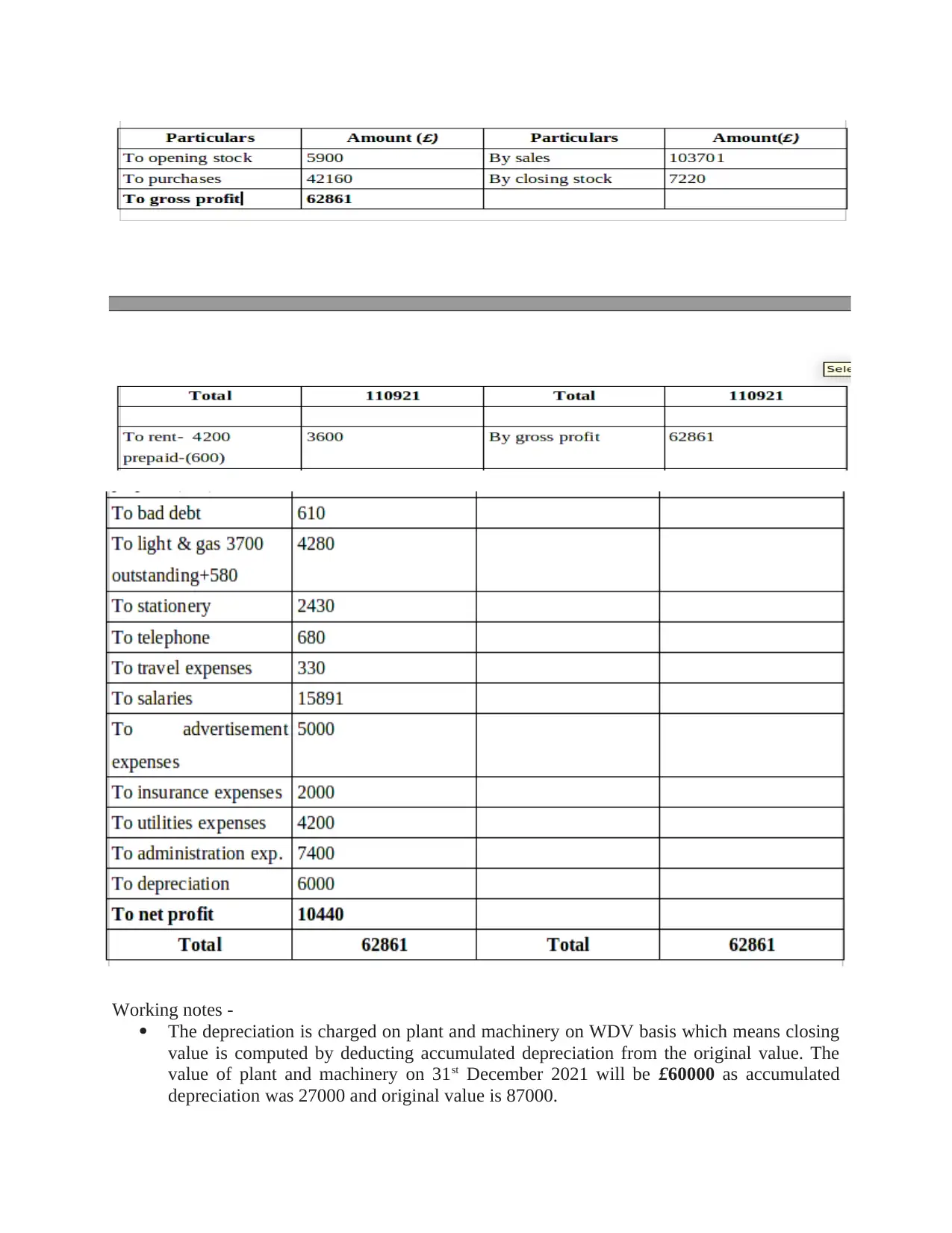
Working notes -
The depreciation is charged on plant and machinery on WDV basis which means closing
value is computed by deducting accumulated depreciation from the original value. The
value of plant and machinery on 31st December 2021 will be £60000 as accumulated
depreciation was 27000 and original value is 87000.
The depreciation is charged on plant and machinery on WDV basis which means closing
value is computed by deducting accumulated depreciation from the original value. The
value of plant and machinery on 31st December 2021 will be £60000 as accumulated
depreciation was 27000 and original value is 87000.

Outstanding expenses means some expenditure which becomes due but yet to paid in this
recent financial year. It should be shown as in liability head in balance sheet as an
outstanding expense.
In this sole trader's profit and loss, outstanding expense of light and gas is £580 which is
to be added in original figure. Now the current year expense of light and gas now 3700 +
580 = 4280.
prepaid expenses means which is paid in advance but does not relate to this year. It is to
be treated as asset of business which is placed in balance sheet at assets side.
In this profit and loss, the rent for the current year is £4200 which is inclusive of prepaid
rent of £600 is exclude for current year expense. The rent of financial year 2022 is £3600.
Balance sheet of M queen for the year ended 31st December 2021
financial statements of Saurav sounds ( Partnership )
recent financial year. It should be shown as in liability head in balance sheet as an
outstanding expense.
In this sole trader's profit and loss, outstanding expense of light and gas is £580 which is
to be added in original figure. Now the current year expense of light and gas now 3700 +
580 = 4280.
prepaid expenses means which is paid in advance but does not relate to this year. It is to
be treated as asset of business which is placed in balance sheet at assets side.
In this profit and loss, the rent for the current year is £4200 which is inclusive of prepaid
rent of £600 is exclude for current year expense. The rent of financial year 2022 is £3600.
Balance sheet of M queen for the year ended 31st December 2021
financial statements of Saurav sounds ( Partnership )
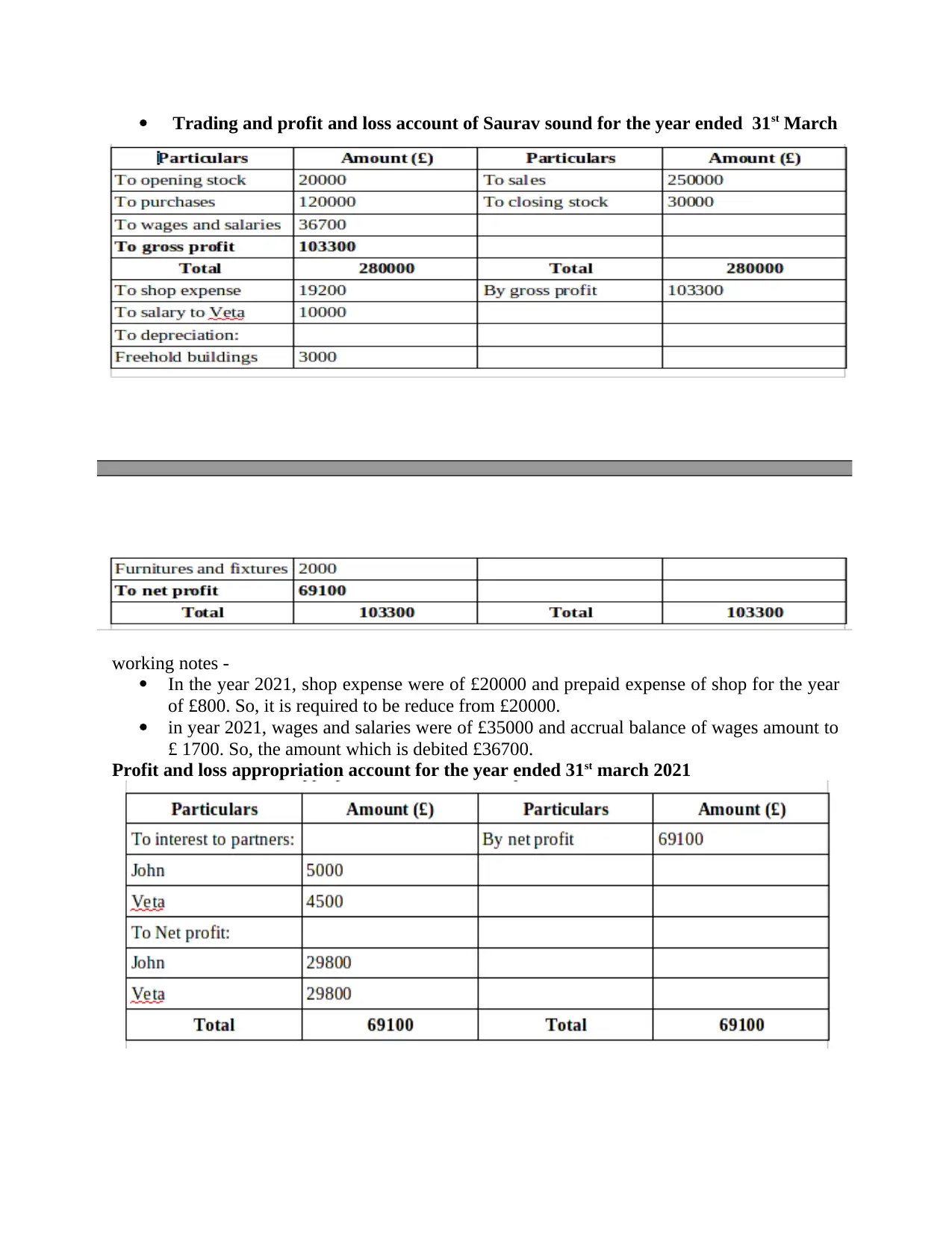
Trading and profit and loss account of Saurav sound for the year ended 31st March
working notes -
In the year 2021, shop expense were of £20000 and prepaid expense of shop for the year
of £800. So, it is required to be reduce from £20000.
in year 2021, wages and salaries were of £35000 and accrual balance of wages amount to
£ 1700. So, the amount which is debited £36700.
Profit and loss appropriation account for the year ended 31st march 2021
working notes -
In the year 2021, shop expense were of £20000 and prepaid expense of shop for the year
of £800. So, it is required to be reduce from £20000.
in year 2021, wages and salaries were of £35000 and accrual balance of wages amount to
£ 1700. So, the amount which is debited £36700.
Profit and loss appropriation account for the year ended 31st march 2021
Secure Best Marks with AI Grader
Need help grading? Try our AI Grader for instant feedback on your assignments.
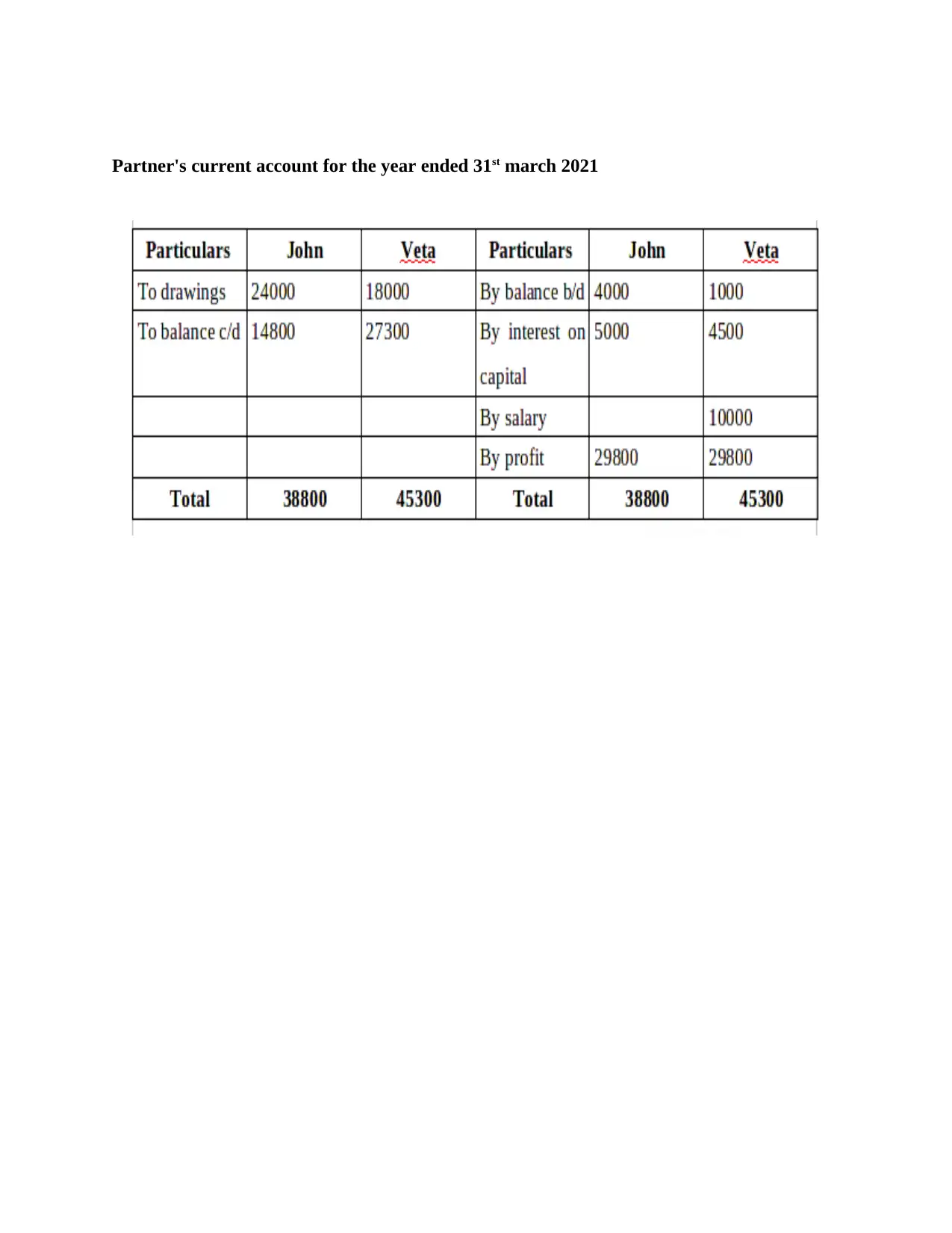
Partner's current account for the year ended 31st march 2021
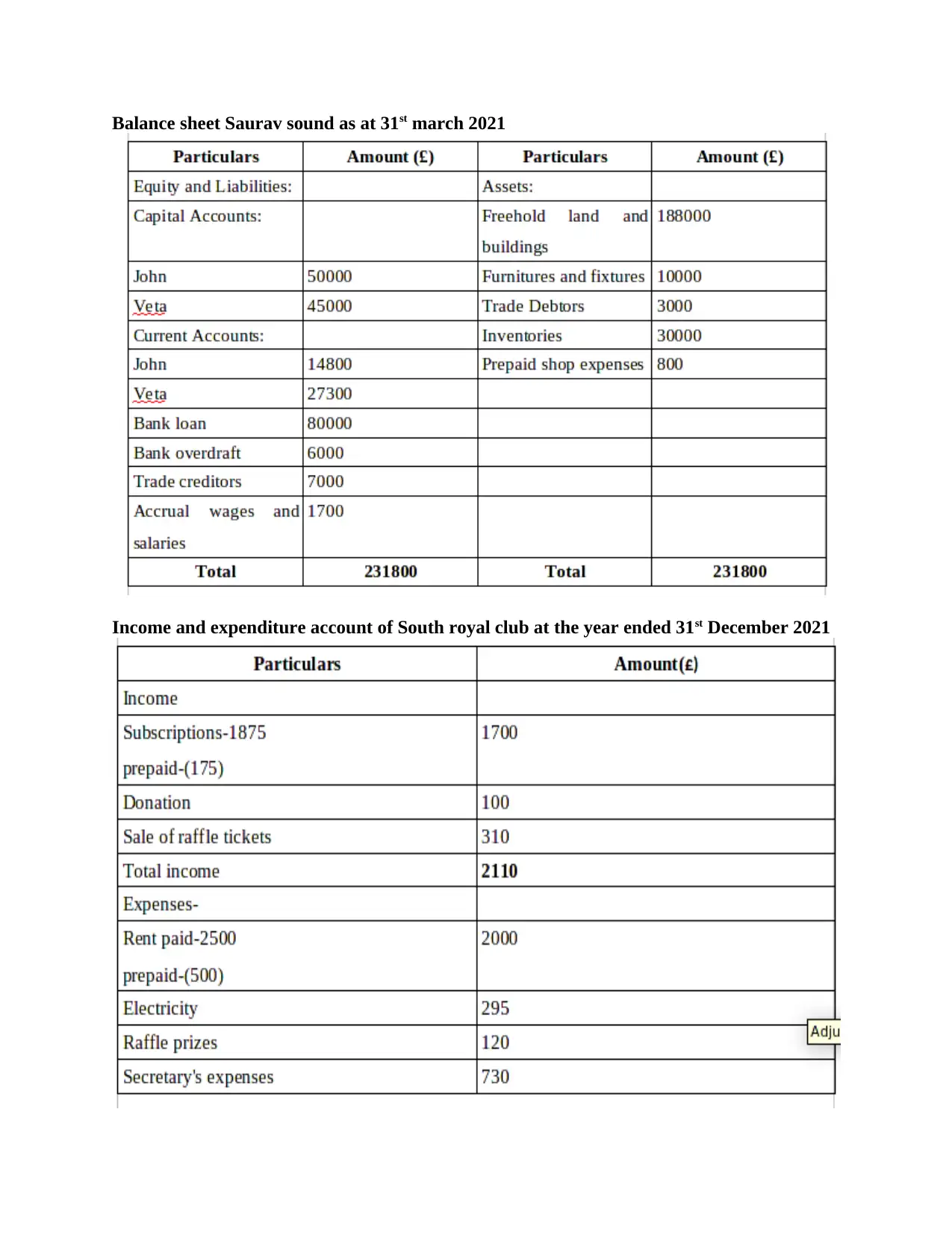
Balance sheet Saurav sound as at 31st march 2021
Income and expenditure account of South royal club at the year ended 31st December 2021
Income and expenditure account of South royal club at the year ended 31st December 2021
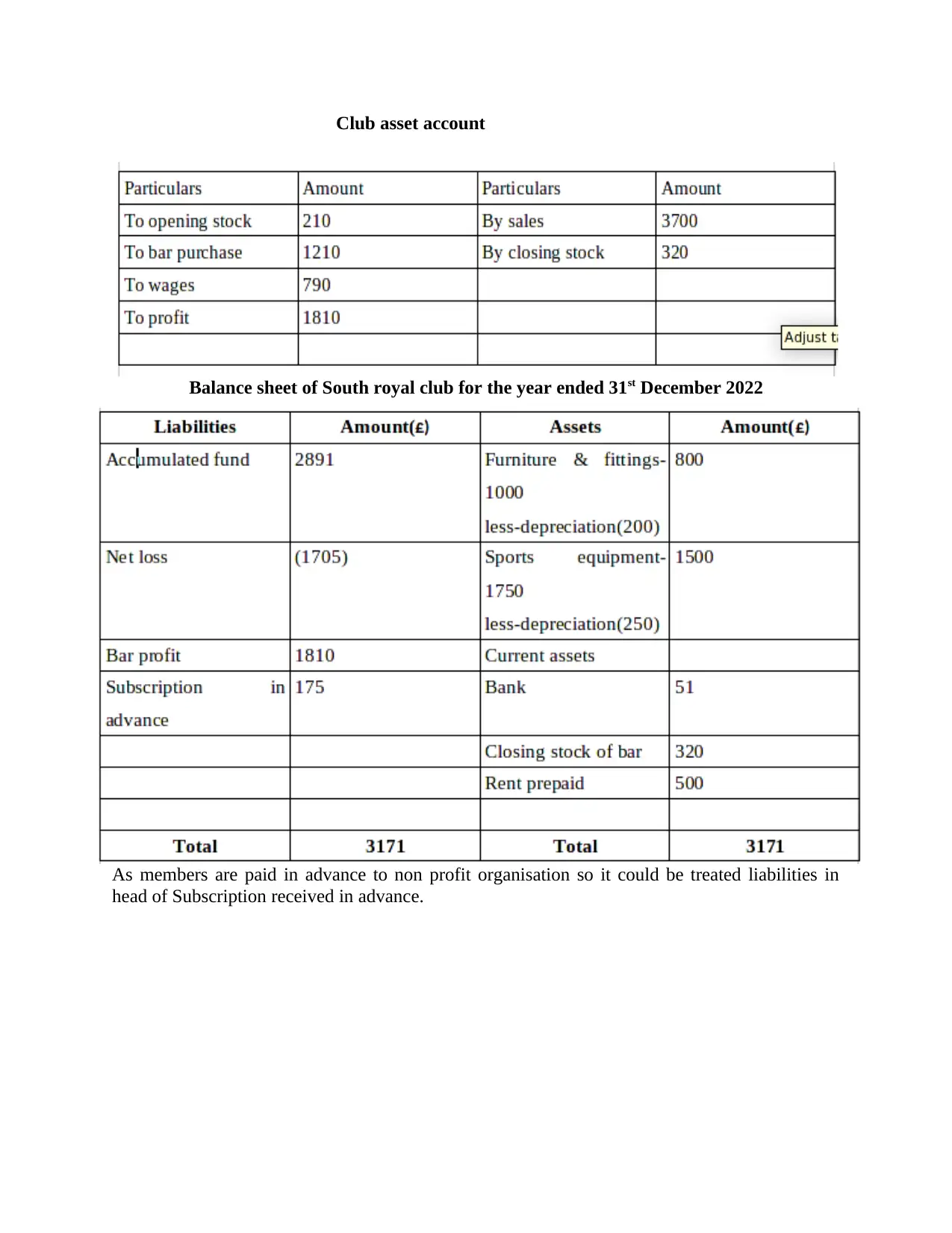
Club asset account
Balance sheet of South royal club for the year ended 31st December 2022
As members are paid in advance to non profit organisation so it could be treated liabilities in
head of Subscription received in advance.
Balance sheet of South royal club for the year ended 31st December 2022
As members are paid in advance to non profit organisation so it could be treated liabilities in
head of Subscription received in advance.
Paraphrase This Document
Need a fresh take? Get an instant paraphrase of this document with our AI Paraphraser
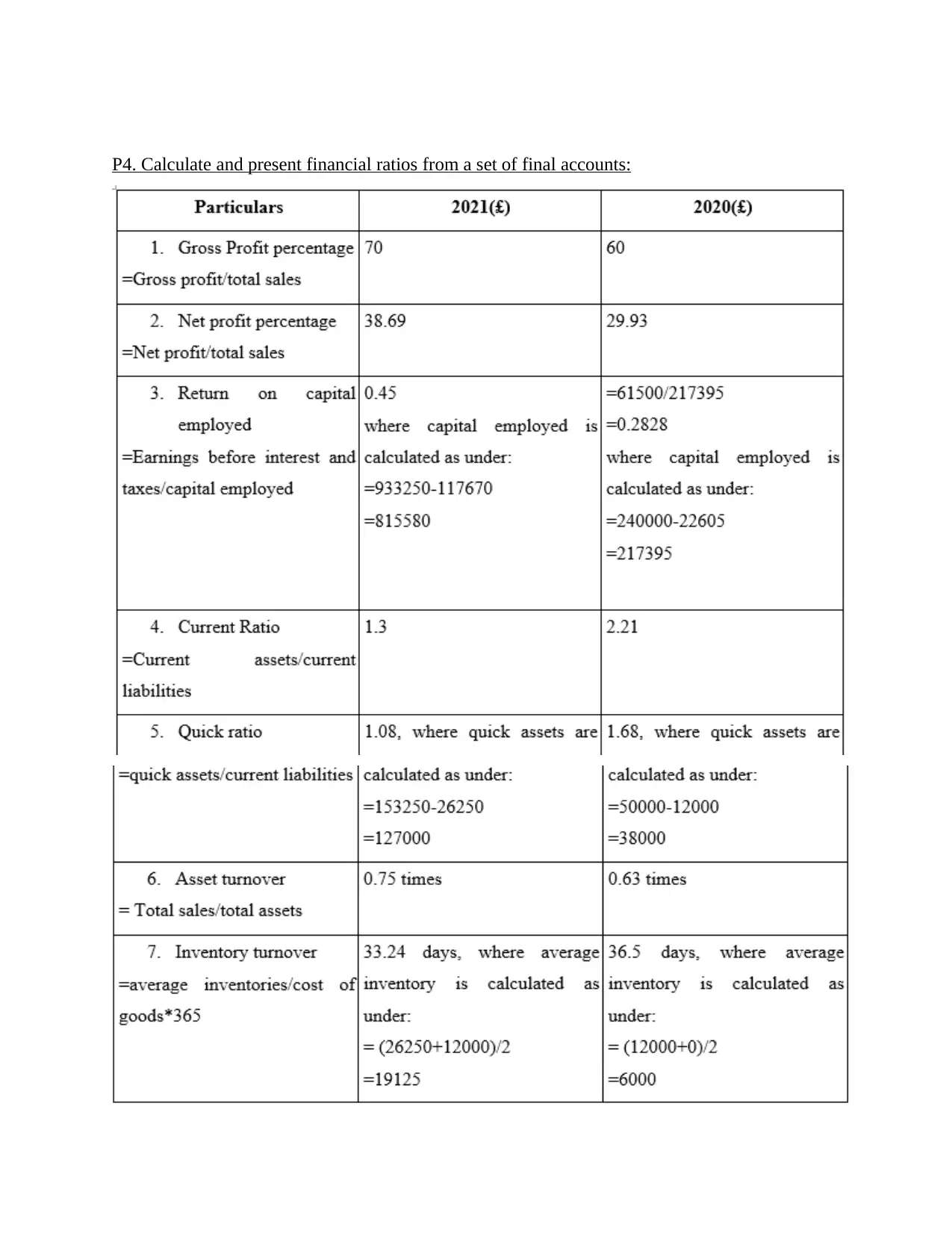
P4. Calculate and present financial ratios from a set of final accounts:

P5. Compare the performance of an organisation over time using financial ratios.
Gross profit ratio: - Gross profit ratio shows that how the efficiently and effectively the
organisation is using their resources through which they can earn large amount profit throughout
the year. From the calculation the gross profit by the help of financial statement it can observed
that in the year 2020 the gross profit of the organisation was only 60% which get increase to 70%
in the year 2021. It means in the year 2021 they have use their resources more effectively then
the last year (Mashayekhi, Ghaemi and Mohammadpour, 2020)
.
Net Profit Ratio- This ratio shows how much profit the organisation can earn by the doing
their operation in the year. In the year 2021 the net profit ratio of the company was only 38.69%
which is higher as compare to the year 2020. In the last the net profit ratio only 29.93%. It means
that in the year 2021 the organisation had reduced their administration expenses and do their
operation more effectively.
Return on Capital Employed- By the help of this ratio the organisation can analysed that
how much return they will get from the capital which the invest. After calculating this ratio, it
can be observed that in the year 2020 it was 0.28 which is lower as compare to the year 2021. In
the year 2021 it was 0.45. It means that in the year 2021 the organisation has use their capital and
perform well in the organisation.
Current Ratio: Current ratio shows the how fast the company can pay their short term
liability by using their current assets. In the year 2020 the current ratio of the organisation was
2.21: 1 which shows the favourable condition for the organisation. It means that the company
have enough current assets through which they can they pay their short term liability by using
current assets. In the year 2020 the current ratio gets decrease it means that the current liability of
the organisation get increase.
Quick Ratio: It shows that how effectively the organisation has use their liquidity by paying
their short term obligation. From the above result it can clearly visible that the organisation has
use their quick assets more effective in the year 2020 as compare to the year 2021. It is because
the in the year 2020 they have use their liquid assets more.
Inventory Turnover Ratio: Inventory Turnover ratio how often the company replace their
inventory relative to their cost of sales. The higher inventory ratio is the favourable condition for
the organisation. From the result it can be observed that in the year 2020 the inventory ratio was
Gross profit ratio: - Gross profit ratio shows that how the efficiently and effectively the
organisation is using their resources through which they can earn large amount profit throughout
the year. From the calculation the gross profit by the help of financial statement it can observed
that in the year 2020 the gross profit of the organisation was only 60% which get increase to 70%
in the year 2021. It means in the year 2021 they have use their resources more effectively then
the last year (Mashayekhi, Ghaemi and Mohammadpour, 2020)
.
Net Profit Ratio- This ratio shows how much profit the organisation can earn by the doing
their operation in the year. In the year 2021 the net profit ratio of the company was only 38.69%
which is higher as compare to the year 2020. In the last the net profit ratio only 29.93%. It means
that in the year 2021 the organisation had reduced their administration expenses and do their
operation more effectively.
Return on Capital Employed- By the help of this ratio the organisation can analysed that
how much return they will get from the capital which the invest. After calculating this ratio, it
can be observed that in the year 2020 it was 0.28 which is lower as compare to the year 2021. In
the year 2021 it was 0.45. It means that in the year 2021 the organisation has use their capital and
perform well in the organisation.
Current Ratio: Current ratio shows the how fast the company can pay their short term
liability by using their current assets. In the year 2020 the current ratio of the organisation was
2.21: 1 which shows the favourable condition for the organisation. It means that the company
have enough current assets through which they can they pay their short term liability by using
current assets. In the year 2020 the current ratio gets decrease it means that the current liability of
the organisation get increase.
Quick Ratio: It shows that how effectively the organisation has use their liquidity by paying
their short term obligation. From the above result it can clearly visible that the organisation has
use their quick assets more effective in the year 2020 as compare to the year 2021. It is because
the in the year 2020 they have use their liquid assets more.
Inventory Turnover Ratio: Inventory Turnover ratio how often the company replace their
inventory relative to their cost of sales. The higher inventory ratio is the favourable condition for
the organisation. From the result it can be observed that in the year 2020 the inventory ratio was

only 33.24 days and in the year 2021 it gets increase to 36.5 days it means that the sales of the
inventory get increase in the year 2021 because of reducing of lockdown restriction due to Covid
19 pandemic.
P6. Cash budget
The forecast of cash inflow and outflow in a business called as cash budget. It may be
organized month-to-month, quarterly, weekly and yearly (Quinn, Oliveira and Santidrián, 2021).
To use of cash finances may be pick out how lots coins to be had to retain the business. It is kind
of quick time period and long time. Using Short time period cash budget can be decided the cash
is wanted for month-to-month and weekly,long time cash budget may be decided the coins is
wanted for lengthy time. On the premise of this finances to decide the excess cash can put money
into marketable securities.
The diagrammatic representation show surplus and deficit in cash and cash equivalent are as
The Cash budget from the year 2020 are as follows –
RAJ SHOP
Cash Budget
inventory get increase in the year 2021 because of reducing of lockdown restriction due to Covid
19 pandemic.
P6. Cash budget
The forecast of cash inflow and outflow in a business called as cash budget. It may be
organized month-to-month, quarterly, weekly and yearly (Quinn, Oliveira and Santidrián, 2021).
To use of cash finances may be pick out how lots coins to be had to retain the business. It is kind
of quick time period and long time. Using Short time period cash budget can be decided the cash
is wanted for month-to-month and weekly,long time cash budget may be decided the coins is
wanted for lengthy time. On the premise of this finances to decide the excess cash can put money
into marketable securities.
The diagrammatic representation show surplus and deficit in cash and cash equivalent are as
The Cash budget from the year 2020 are as follows –
RAJ SHOP
Cash Budget
Secure Best Marks with AI Grader
Need help grading? Try our AI Grader for instant feedback on your assignments.
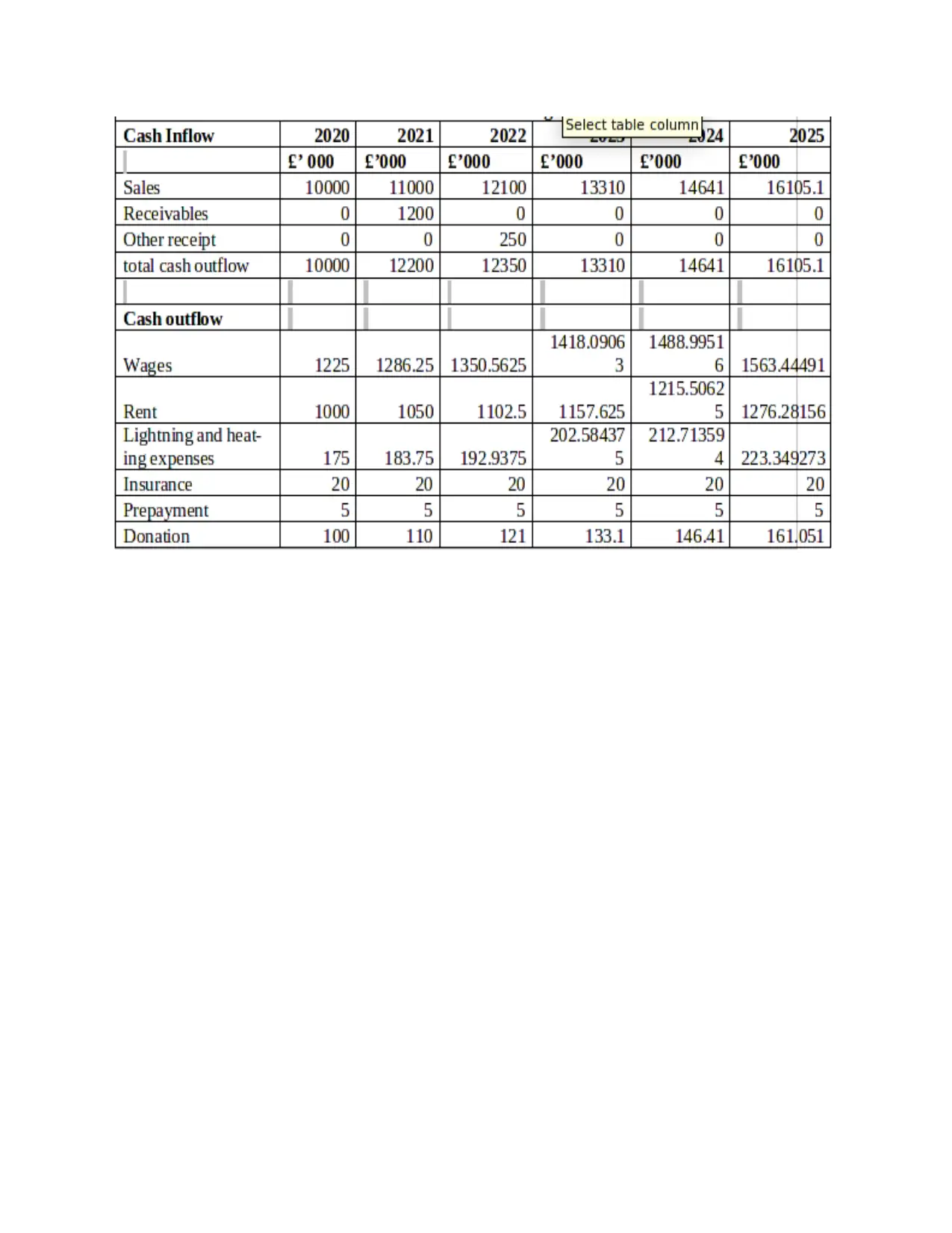
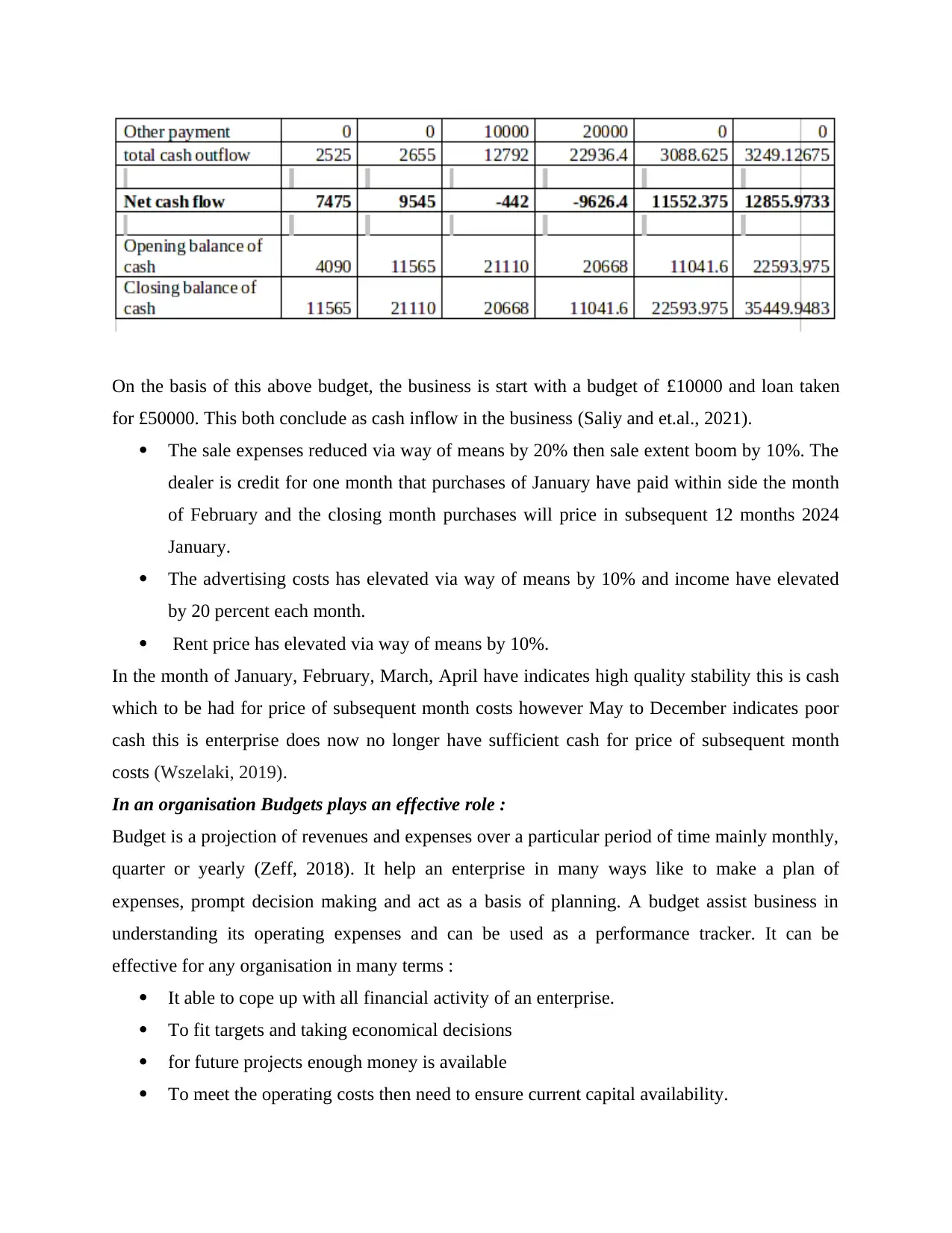
On the basis of this above budget, the business is start with a budget of £10000 and loan taken
for £50000. This both conclude as cash inflow in the business (Saliy and et.al., 2021).
The sale expenses reduced via way of means by 20% then sale extent boom by 10%. The
dealer is credit for one month that purchases of January have paid within side the month
of February and the closing month purchases will price in subsequent 12 months 2024
January.
The advertising costs has elevated via way of means by 10% and income have elevated
by 20 percent each month.
Rent price has elevated via way of means by 10%.
In the month of January, February, March, April have indicates high quality stability this is cash
which to be had for price of subsequent month costs however May to December indicates poor
cash this is enterprise does now no longer have sufficient cash for price of subsequent month
costs (Wszelaki, 2019).
In an organisation Budgets plays an effective role :
Budget is a projection of revenues and expenses over a particular period of time mainly monthly,
quarter or yearly (Zeff, 2018). It help an enterprise in many ways like to make a plan of
expenses, prompt decision making and act as a basis of planning. A budget assist business in
understanding its operating expenses and can be used as a performance tracker. It can be
effective for any organisation in many terms :
It able to cope up with all financial activity of an enterprise.
To fit targets and taking economical decisions
for future projects enough money is available
To meet the operating costs then need to ensure current capital availability.
for £50000. This both conclude as cash inflow in the business (Saliy and et.al., 2021).
The sale expenses reduced via way of means by 20% then sale extent boom by 10%. The
dealer is credit for one month that purchases of January have paid within side the month
of February and the closing month purchases will price in subsequent 12 months 2024
January.
The advertising costs has elevated via way of means by 10% and income have elevated
by 20 percent each month.
Rent price has elevated via way of means by 10%.
In the month of January, February, March, April have indicates high quality stability this is cash
which to be had for price of subsequent month costs however May to December indicates poor
cash this is enterprise does now no longer have sufficient cash for price of subsequent month
costs (Wszelaki, 2019).
In an organisation Budgets plays an effective role :
Budget is a projection of revenues and expenses over a particular period of time mainly monthly,
quarter or yearly (Zeff, 2018). It help an enterprise in many ways like to make a plan of
expenses, prompt decision making and act as a basis of planning. A budget assist business in
understanding its operating expenses and can be used as a performance tracker. It can be
effective for any organisation in many terms :
It able to cope up with all financial activity of an enterprise.
To fit targets and taking economical decisions
for future projects enough money is available
To meet the operating costs then need to ensure current capital availability.
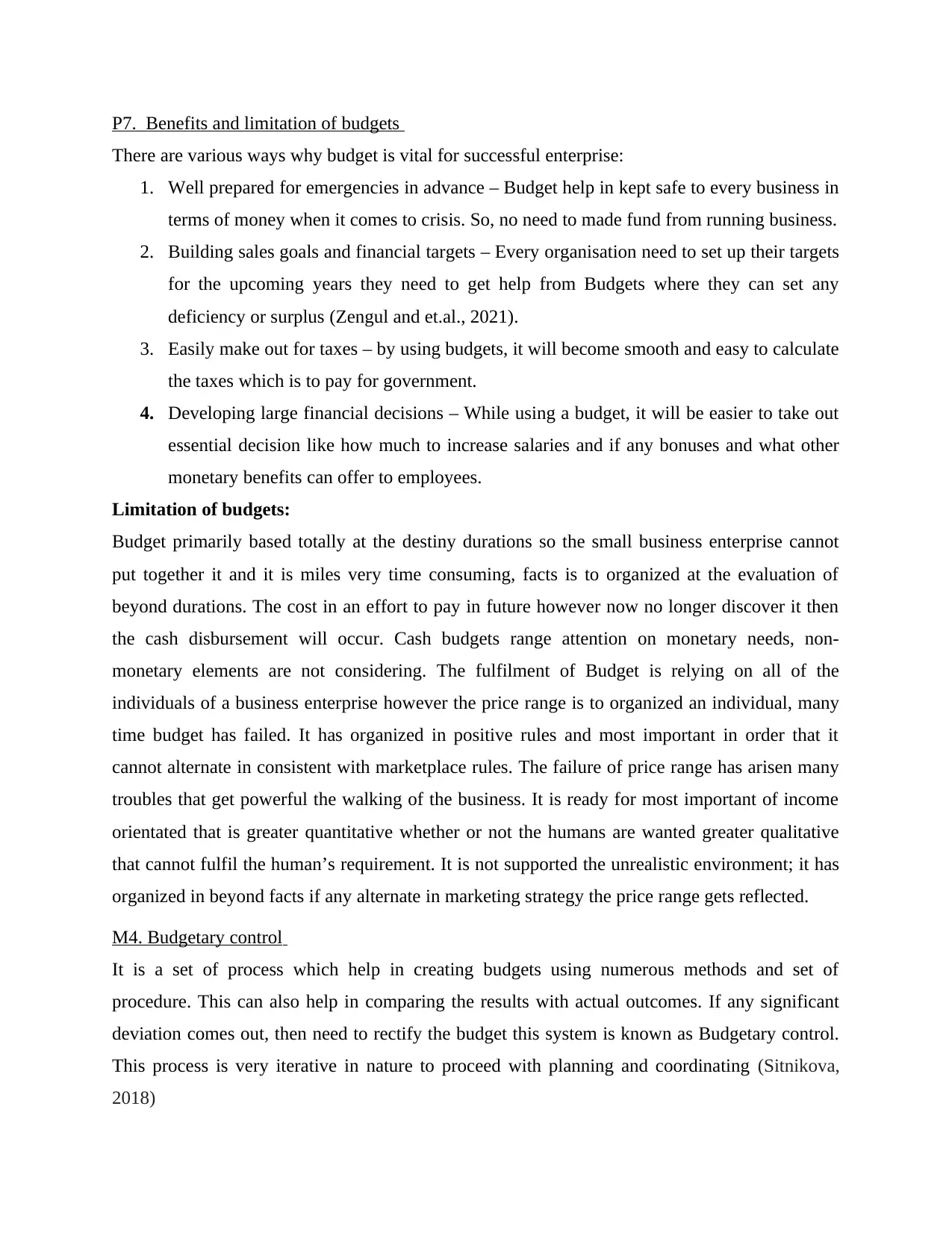
P7. Benefits and limitation of budgets
There are various ways why budget is vital for successful enterprise:
1. Well prepared for emergencies in advance – Budget help in kept safe to every business in
terms of money when it comes to crisis. So, no need to made fund from running business.
2. Building sales goals and financial targets – Every organisation need to set up their targets
for the upcoming years they need to get help from Budgets where they can set any
deficiency or surplus (Zengul and et.al., 2021).
3. Easily make out for taxes – by using budgets, it will become smooth and easy to calculate
the taxes which is to pay for government.
4. Developing large financial decisions – While using a budget, it will be easier to take out
essential decision like how much to increase salaries and if any bonuses and what other
monetary benefits can offer to employees.
Limitation of budgets:
Budget primarily based totally at the destiny durations so the small business enterprise cannot
put together it and it is miles very time consuming, facts is to organized at the evaluation of
beyond durations. The cost in an effort to pay in future however now no longer discover it then
the cash disbursement will occur. Cash budgets range attention on monetary needs, non-
monetary elements are not considering. The fulfilment of Budget is relying on all of the
individuals of a business enterprise however the price range is to organized an individual, many
time budget has failed. It has organized in positive rules and most important in order that it
cannot alternate in consistent with marketplace rules. The failure of price range has arisen many
troubles that get powerful the walking of the business. It is ready for most important of income
orientated that is greater quantitative whether or not the humans are wanted greater qualitative
that cannot fulfil the human’s requirement. It is not supported the unrealistic environment; it has
organized in beyond facts if any alternate in marketing strategy the price range gets reflected.
M4. Budgetary control
It is a set of process which help in creating budgets using numerous methods and set of
procedure. This can also help in comparing the results with actual outcomes. If any significant
deviation comes out, then need to rectify the budget this system is known as Budgetary control.
This process is very iterative in nature to proceed with planning and coordinating (Sitnikova,
2018)
There are various ways why budget is vital for successful enterprise:
1. Well prepared for emergencies in advance – Budget help in kept safe to every business in
terms of money when it comes to crisis. So, no need to made fund from running business.
2. Building sales goals and financial targets – Every organisation need to set up their targets
for the upcoming years they need to get help from Budgets where they can set any
deficiency or surplus (Zengul and et.al., 2021).
3. Easily make out for taxes – by using budgets, it will become smooth and easy to calculate
the taxes which is to pay for government.
4. Developing large financial decisions – While using a budget, it will be easier to take out
essential decision like how much to increase salaries and if any bonuses and what other
monetary benefits can offer to employees.
Limitation of budgets:
Budget primarily based totally at the destiny durations so the small business enterprise cannot
put together it and it is miles very time consuming, facts is to organized at the evaluation of
beyond durations. The cost in an effort to pay in future however now no longer discover it then
the cash disbursement will occur. Cash budgets range attention on monetary needs, non-
monetary elements are not considering. The fulfilment of Budget is relying on all of the
individuals of a business enterprise however the price range is to organized an individual, many
time budget has failed. It has organized in positive rules and most important in order that it
cannot alternate in consistent with marketplace rules. The failure of price range has arisen many
troubles that get powerful the walking of the business. It is ready for most important of income
orientated that is greater quantitative whether or not the humans are wanted greater qualitative
that cannot fulfil the human’s requirement. It is not supported the unrealistic environment; it has
organized in beyond facts if any alternate in marketing strategy the price range gets reflected.
M4. Budgetary control
It is a set of process which help in creating budgets using numerous methods and set of
procedure. This can also help in comparing the results with actual outcomes. If any significant
deviation comes out, then need to rectify the budget this system is known as Budgetary control.
This process is very iterative in nature to proceed with planning and coordinating (Sitnikova,
2018)
Paraphrase This Document
Need a fresh take? Get an instant paraphrase of this document with our AI Paraphraser

.
The solution to problems that revealed by budgetary planning and control for effective
organisation decision making are -
Budgetary control responsibility centre
Revenue centre – The actual output is compared in financial terms and are not compare
with actual input cost.
Expense centre – the budgeted output produced to be contrast with previous year’s budget and
this will not compare to actual units (Gujarathi, Dugar and Ruff, 2022).
Profit centre – the differences are to be find out in incomes and costs then inter
departmental transfer price to be used where method is to cost plus profit price.
Investment centre – when units compared to assets it producing interest rate.
D3 Budgetary controls helps in decision making
Budget is a financial tool which is generally prepared by company's management. For
effectiveness in budgetary control, they need to follow top down system where employees can
participate so that budget is efficient for future requirement. This price range enables value
control to lessen value the use of budgetary manage techniques. The business enterprise does
now no longer have information new approach and inner manage, price range proprietor talks to
the finance branch and taking choice primarily based totally on future events (Pesci and Girardi,
2021). It enables in coordinating all enterprise activities then taking choice of future in line with
new era and method. Budget feature are interlinked with every other, powerful implementation
price range relies upon on all departments. To examine of market, accrued applicable records
which enables in guidance of future price range and taking choice primarily based totally on
upcoming events.
CONCLUSION
From the above it is concluded that the accounting principle is very important for the
operations of the business. It is because through they can assess the activities of the organisation
that they are earning profit or loss. Due to this they are able to know that they can operate the
business in future. If they did not earn enough profit, then they have to make more effective
planning. If the planning of the organisation is effective, then the organisation then they can earn
The solution to problems that revealed by budgetary planning and control for effective
organisation decision making are -
Budgetary control responsibility centre
Revenue centre – The actual output is compared in financial terms and are not compare
with actual input cost.
Expense centre – the budgeted output produced to be contrast with previous year’s budget and
this will not compare to actual units (Gujarathi, Dugar and Ruff, 2022).
Profit centre – the differences are to be find out in incomes and costs then inter
departmental transfer price to be used where method is to cost plus profit price.
Investment centre – when units compared to assets it producing interest rate.
D3 Budgetary controls helps in decision making
Budget is a financial tool which is generally prepared by company's management. For
effectiveness in budgetary control, they need to follow top down system where employees can
participate so that budget is efficient for future requirement. This price range enables value
control to lessen value the use of budgetary manage techniques. The business enterprise does
now no longer have information new approach and inner manage, price range proprietor talks to
the finance branch and taking choice primarily based totally on future events (Pesci and Girardi,
2021). It enables in coordinating all enterprise activities then taking choice of future in line with
new era and method. Budget feature are interlinked with every other, powerful implementation
price range relies upon on all departments. To examine of market, accrued applicable records
which enables in guidance of future price range and taking choice primarily based totally on
upcoming events.
CONCLUSION
From the above it is concluded that the accounting principle is very important for the
operations of the business. It is because through they can assess the activities of the organisation
that they are earning profit or loss. Due to this they are able to know that they can operate the
business in future. If they did not earn enough profit, then they have to make more effective
planning. If the planning of the organisation is effective, then the organisation then they can earn
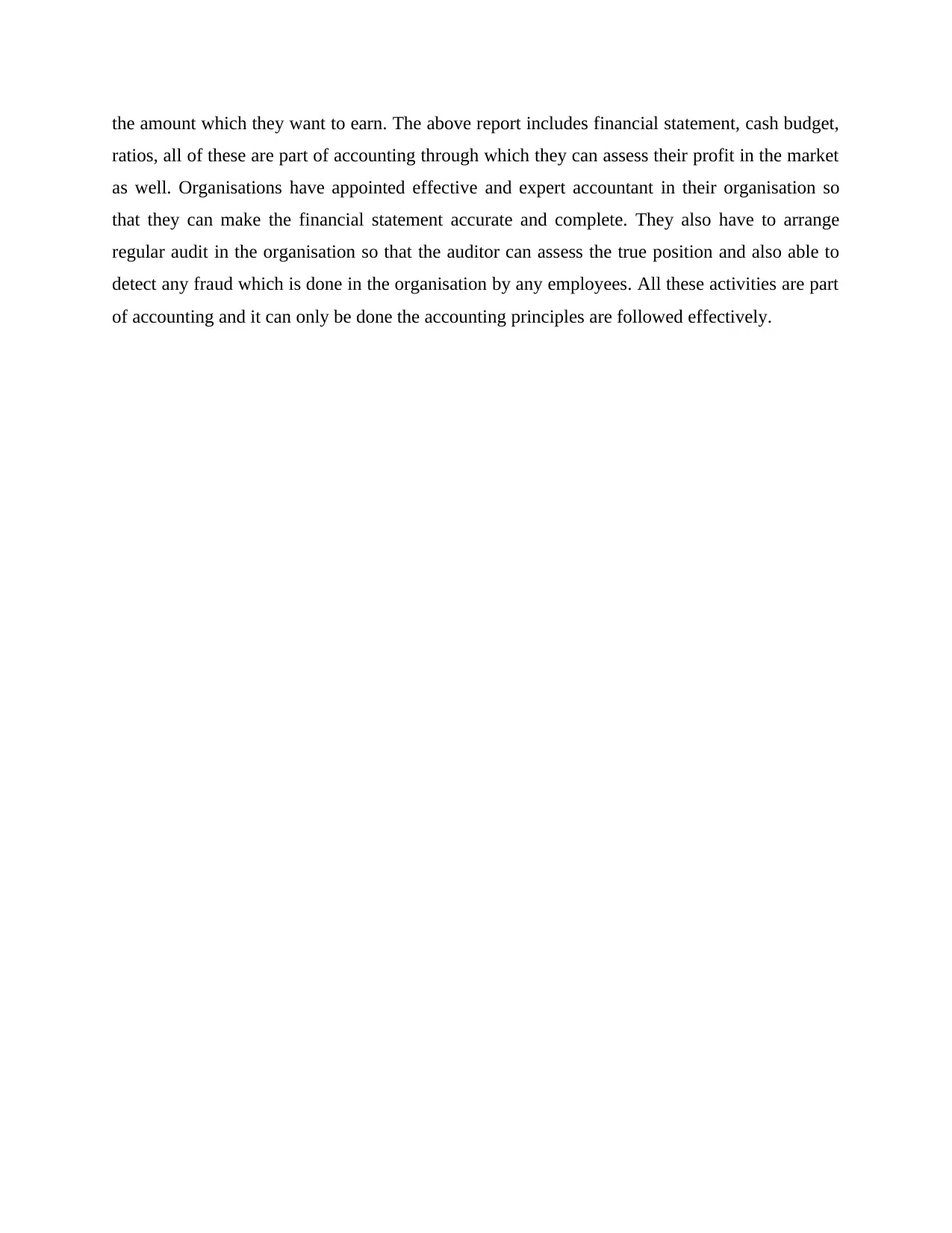
the amount which they want to earn. The above report includes financial statement, cash budget,
ratios, all of these are part of accounting through which they can assess their profit in the market
as well. Organisations have appointed effective and expert accountant in their organisation so
that they can make the financial statement accurate and complete. They also have to arrange
regular audit in the organisation so that the auditor can assess the true position and also able to
detect any fraud which is done in the organisation by any employees. All these activities are part
of accounting and it can only be done the accounting principles are followed effectively.
ratios, all of these are part of accounting through which they can assess their profit in the market
as well. Organisations have appointed effective and expert accountant in their organisation so
that they can make the financial statement accurate and complete. They also have to arrange
regular audit in the organisation so that the auditor can assess the true position and also able to
detect any fraud which is done in the organisation by any employees. All these activities are part
of accounting and it can only be done the accounting principles are followed effectively.
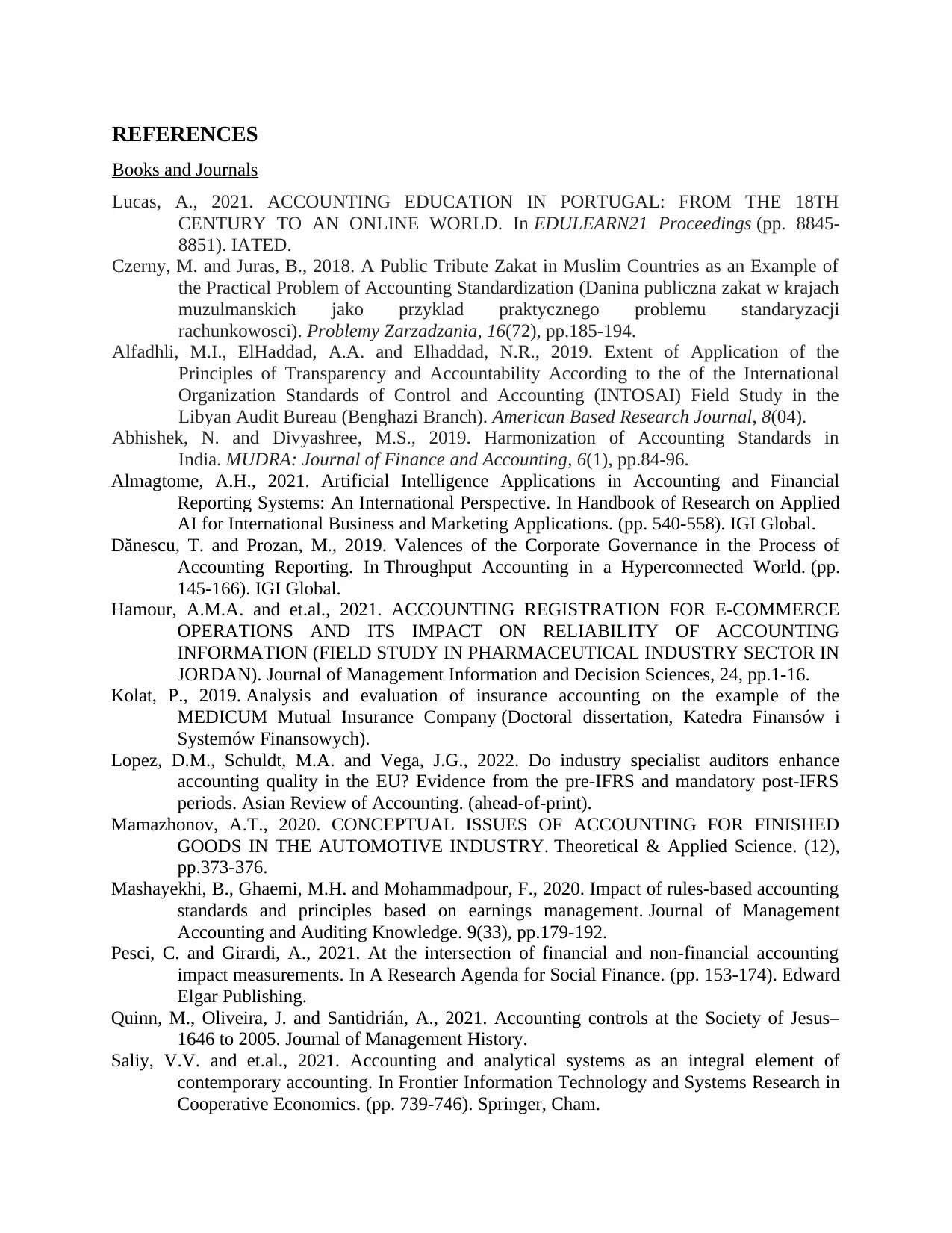
REFERENCES
Books and Journals
Lucas, A., 2021. ACCOUNTING EDUCATION IN PORTUGAL: FROM THE 18TH
CENTURY TO AN ONLINE WORLD. In EDULEARN21 Proceedings (pp. 8845-
8851). IATED.
Czerny, M. and Juras, B., 2018. A Public Tribute Zakat in Muslim Countries as an Example of
the Practical Problem of Accounting Standardization (Danina publiczna zakat w krajach
muzulmanskich jako przyklad praktycznego problemu standaryzacji
rachunkowosci). Problemy Zarzadzania, 16(72), pp.185-194.
Alfadhli, M.I., ElHaddad, A.A. and Elhaddad, N.R., 2019. Extent of Application of the
Principles of Transparency and Accountability According to the of the International
Organization Standards of Control and Accounting (INTOSAI) Field Study in the
Libyan Audit Bureau (Benghazi Branch). American Based Research Journal, 8(04).
Abhishek, N. and Divyashree, M.S., 2019. Harmonization of Accounting Standards in
India. MUDRA: Journal of Finance and Accounting, 6(1), pp.84-96.
Almagtome, A.H., 2021. Artificial Intelligence Applications in Accounting and Financial
Reporting Systems: An International Perspective. In Handbook of Research on Applied
AI for International Business and Marketing Applications. (pp. 540-558). IGI Global.
Dănescu, T. and Prozan, M., 2019. Valences of the Corporate Governance in the Process of
Accounting Reporting. In Throughput Accounting in a Hyperconnected World. (pp.
145-166). IGI Global.
Hamour, A.M.A. and et.al., 2021. ACCOUNTING REGISTRATION FOR E-COMMERCE
OPERATIONS AND ITS IMPACT ON RELIABILITY OF ACCOUNTING
INFORMATION (FIELD STUDY IN PHARMACEUTICAL INDUSTRY SECTOR IN
JORDAN). Journal of Management Information and Decision Sciences, 24, pp.1-16.
Kolat, P., 2019. Analysis and evaluation of insurance accounting on the example of the
MEDICUM Mutual Insurance Company (Doctoral dissertation, Katedra Finansów i
Systemów Finansowych).
Lopez, D.M., Schuldt, M.A. and Vega, J.G., 2022. Do industry specialist auditors enhance
accounting quality in the EU? Evidence from the pre-IFRS and mandatory post-IFRS
periods. Asian Review of Accounting. (ahead-of-print).
Mamazhonov, A.T., 2020. CONCEPTUAL ISSUES OF ACCOUNTING FOR FINISHED
GOODS IN THE AUTOMOTIVE INDUSTRY. Theoretical & Applied Science. (12),
pp.373-376.
Mashayekhi, B., Ghaemi, M.H. and Mohammadpour, F., 2020. Impact of rules-based accounting
standards and principles based on earnings management. Journal of Management
Accounting and Auditing Knowledge. 9(33), pp.179-192.
Pesci, C. and Girardi, A., 2021. At the intersection of financial and non-financial accounting
impact measurements. In A Research Agenda for Social Finance. (pp. 153-174). Edward
Elgar Publishing.
Quinn, M., Oliveira, J. and Santidrián, A., 2021. Accounting controls at the Society of Jesus–
1646 to 2005. Journal of Management History.
Saliy, V.V. and et.al., 2021. Accounting and analytical systems as an integral element of
contemporary accounting. In Frontier Information Technology and Systems Research in
Cooperative Economics. (pp. 739-746). Springer, Cham.
Books and Journals
Lucas, A., 2021. ACCOUNTING EDUCATION IN PORTUGAL: FROM THE 18TH
CENTURY TO AN ONLINE WORLD. In EDULEARN21 Proceedings (pp. 8845-
8851). IATED.
Czerny, M. and Juras, B., 2018. A Public Tribute Zakat in Muslim Countries as an Example of
the Practical Problem of Accounting Standardization (Danina publiczna zakat w krajach
muzulmanskich jako przyklad praktycznego problemu standaryzacji
rachunkowosci). Problemy Zarzadzania, 16(72), pp.185-194.
Alfadhli, M.I., ElHaddad, A.A. and Elhaddad, N.R., 2019. Extent of Application of the
Principles of Transparency and Accountability According to the of the International
Organization Standards of Control and Accounting (INTOSAI) Field Study in the
Libyan Audit Bureau (Benghazi Branch). American Based Research Journal, 8(04).
Abhishek, N. and Divyashree, M.S., 2019. Harmonization of Accounting Standards in
India. MUDRA: Journal of Finance and Accounting, 6(1), pp.84-96.
Almagtome, A.H., 2021. Artificial Intelligence Applications in Accounting and Financial
Reporting Systems: An International Perspective. In Handbook of Research on Applied
AI for International Business and Marketing Applications. (pp. 540-558). IGI Global.
Dănescu, T. and Prozan, M., 2019. Valences of the Corporate Governance in the Process of
Accounting Reporting. In Throughput Accounting in a Hyperconnected World. (pp.
145-166). IGI Global.
Hamour, A.M.A. and et.al., 2021. ACCOUNTING REGISTRATION FOR E-COMMERCE
OPERATIONS AND ITS IMPACT ON RELIABILITY OF ACCOUNTING
INFORMATION (FIELD STUDY IN PHARMACEUTICAL INDUSTRY SECTOR IN
JORDAN). Journal of Management Information and Decision Sciences, 24, pp.1-16.
Kolat, P., 2019. Analysis and evaluation of insurance accounting on the example of the
MEDICUM Mutual Insurance Company (Doctoral dissertation, Katedra Finansów i
Systemów Finansowych).
Lopez, D.M., Schuldt, M.A. and Vega, J.G., 2022. Do industry specialist auditors enhance
accounting quality in the EU? Evidence from the pre-IFRS and mandatory post-IFRS
periods. Asian Review of Accounting. (ahead-of-print).
Mamazhonov, A.T., 2020. CONCEPTUAL ISSUES OF ACCOUNTING FOR FINISHED
GOODS IN THE AUTOMOTIVE INDUSTRY. Theoretical & Applied Science. (12),
pp.373-376.
Mashayekhi, B., Ghaemi, M.H. and Mohammadpour, F., 2020. Impact of rules-based accounting
standards and principles based on earnings management. Journal of Management
Accounting and Auditing Knowledge. 9(33), pp.179-192.
Pesci, C. and Girardi, A., 2021. At the intersection of financial and non-financial accounting
impact measurements. In A Research Agenda for Social Finance. (pp. 153-174). Edward
Elgar Publishing.
Quinn, M., Oliveira, J. and Santidrián, A., 2021. Accounting controls at the Society of Jesus–
1646 to 2005. Journal of Management History.
Saliy, V.V. and et.al., 2021. Accounting and analytical systems as an integral element of
contemporary accounting. In Frontier Information Technology and Systems Research in
Cooperative Economics. (pp. 739-746). Springer, Cham.
Secure Best Marks with AI Grader
Need help grading? Try our AI Grader for instant feedback on your assignments.
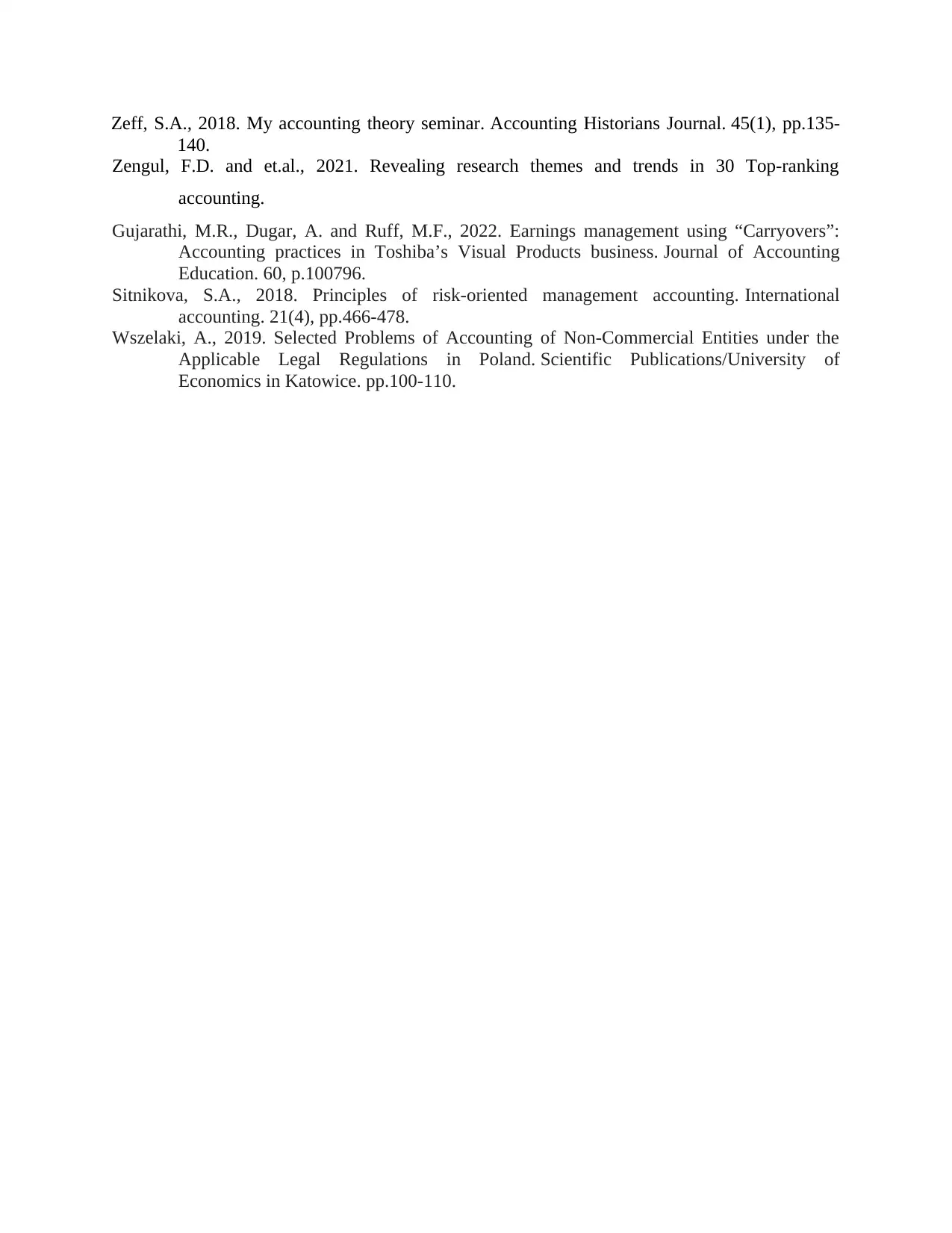
Zeff, S.A., 2018. My accounting theory seminar. Accounting Historians Journal. 45(1), pp.135-
140.
Zengul, F.D. and et.al., 2021. Revealing research themes and trends in 30 Top‐ranking
accounting.
Gujarathi, M.R., Dugar, A. and Ruff, M.F., 2022. Earnings management using “Carryovers”:
Accounting practices in Toshiba’s Visual Products business. Journal of Accounting
Education. 60, p.100796.
Sitnikova, S.A., 2018. Principles of risk-oriented management accounting. International
accounting. 21(4), pp.466-478.
Wszelaki, A., 2019. Selected Problems of Accounting of Non-Commercial Entities under the
Applicable Legal Regulations in Poland. Scientific Publications/University of
Economics in Katowice. pp.100-110.
140.
Zengul, F.D. and et.al., 2021. Revealing research themes and trends in 30 Top‐ranking
accounting.
Gujarathi, M.R., Dugar, A. and Ruff, M.F., 2022. Earnings management using “Carryovers”:
Accounting practices in Toshiba’s Visual Products business. Journal of Accounting
Education. 60, p.100796.
Sitnikova, S.A., 2018. Principles of risk-oriented management accounting. International
accounting. 21(4), pp.466-478.
Wszelaki, A., 2019. Selected Problems of Accounting of Non-Commercial Entities under the
Applicable Legal Regulations in Poland. Scientific Publications/University of
Economics in Katowice. pp.100-110.
1 out of 23
Related Documents
Your All-in-One AI-Powered Toolkit for Academic Success.
+13062052269
info@desklib.com
Available 24*7 on WhatsApp / Email
![[object Object]](/_next/static/media/star-bottom.7253800d.svg)
Unlock your academic potential
© 2024 | Zucol Services PVT LTD | All rights reserved.


